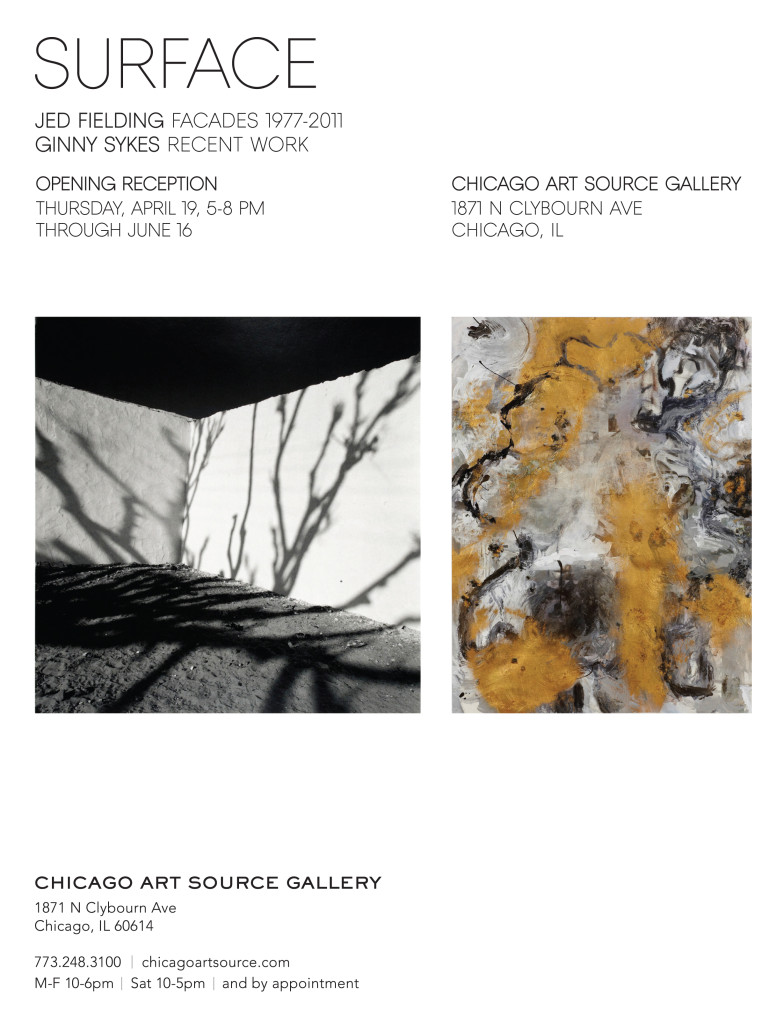Surface
@ Chicago Art Source Gallery
1871 N Clybourn Ave Chicago, IL 60614
Opening Thursday, April 19th, from 5 PM - 8 PM
On view through Tuesday, June 19th
Jed Fielding and Ginny Sykes have had a deep and long-standing friendship for more than thirty years. They have shared a common passion for the photography of Aaron Siskind (with whom Fielding studied extensively, and formed a close relationship with until Siskind’s death in 1991), as well as for world travel with a particular emphasis on Italy. Sykes’ work utilizes a wide variety of media and approaches, while Fielding’s photographs articulate a very specific aesthetic and concern. Despite the apparent disjunction of these two close friends’ work, there is a shared facility for abstraction, formal composition, and, foremost, a passion for pushing the viewer to look at what is before them. There may be occasional overlap, such as when Fielding’s photographs of walls’ surfaces echo Sykes’ painterly abstraction, or when her dance-like gesture of primal forms hints at his photographs of trees, but this is most likely incidental, the result of their shared aesthetic and way of looking at the world.”
“Fielding’s body of work titled Facades hints at a metaphor for a key concept in all of his work ̶ a throwing down of the gauntlet, the notion that the very act of seeing is thrown into question. In these works the outsides of things are replete with content and reference to a world, both inside and out, of places and feelings. Though perhaps better known for his portraiture, these photographs’ extraordinary formal beauty belies their transference of character into place. Fielding has traveled the world and managed to transcend merely capturing the exotic by a sense of assurance that has him finding his perfect moment, not merely in a formal confluence of light and shade and composition, but by what speaks to him, regardless of the inherent beauty, history, function or psychology of the place in question. These qualities may indeed be imbued in the photograph, but what most engages us is their ambiguity and his aesthetic of looking that overrides the specificity of place. In a sense they thus become what some have posited of all art, a self-portrait. So it can be Rome or Mérida or Aswan ̶ it matters more that we are drawn into his acute sense of looking at the world with fresh eyes. The challenge is made: what is it we are viewing?—and, most importantly, what do we see?
Sykes’ most powerful works create a dialectic tension between chaos and order, abstraction and representation, and at times between temporal immediacy and fading memories. Drawings whose intense sense of motion hints at a bodily presence become a kind of Sufi dance of energy. Ambiguous figure/ground relationships often push gestural abstraction towards representation and imagery, which is sometimes bolstered by collaged real world artifacts. Memory and the associational poetry of image are never far behind in these abstractions. Occasionally the artist utilizes symbolic archetypes as focused imagery that hints at spiritual content, whether it is a graceful dance of opposites, a mask-like persona, or blob-like forms that seem like psychic entities. At times Sykes will transform background details or marginalia of her previous work into the starring attraction of a newer work. In addition, her layering of meaning and memory, as well as her varied approach to balancing illusion making with the flat “is-ness” of mark-making and gestural painting all keep the viewer involved with the very process of looking.
Official Website
More events on this date

« previous event
next event »